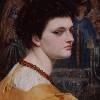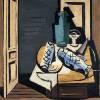Fine art collection
The fine art collection at Norwich Castle comprises works by over 3,500 artists, including approximately 1,300 paintings, 12,000 drawings and watercolours, 11,500 prints and 130 sculptures. Artworks dating from pre-1900 make up the great majority of these.

The collection includes the most comprehensive holdings in existence of works of the nineteenth-century Norwich School of Artists, the first exhibiting art society in Britain outside London. Three generations of some fifty artists are well represented, including leading members John Crome (1768-1821) and John Sell Cotman (1782-1842), both of whom have international reputations in their own right. The Norwich School artists found subjects for their paintings primarily in Norwich and the countryside and coastline of Norfolk, but not exclusively so. In common with their contemporaries, they also toured the British Isles and the continent in search of subject matter.
The museum's collection of British and European School paintings of the eighteenth and nineteenth centuries aims to represent the development of British painting and to place the Norwich School in context. The rich cultural heritage of the area had enabled the Castle to acquire many fine works with a Norfolk provenance. The Castle is also responsible for the City's collection of over a hundred Civic Portraits, mainly of Mayors of Norwich, local MPs and other dignitaries. This is an important collection dating from the late sixteenth century to the twentieth century; artists include Thomas Gainsborough, Thomas Lawrence, William Beechey and John Opie.
Demonstrating the cultural cross-fertilisation between Norwich and the Low Countries, Dutch and Flemish art is well represented within the collection with artists of the calibre of Pieter Breughel the Younger, Cornelis Engelsz, Willem Claesz. Heda, Meindert Hobbema and Aert van der Neer, as well as 93 etchings and one drawing by Rembrandt.
Post 1900, the museum holds a world-class collection of international twentieth-century art bequeathed to the East Anglia Art Fund in 1993 by Lady Jane Adeane and on permanent loan to the museum. The bequest includes works by artists such as Marie Laurencin, Francis Picabia, August Rodin and Andy Warhol. Paintings by René Magritte and Maurice Vlaminck from the original bequest were accepted in lieu of tax by HM Government and allocated to Norwich Castle.
In common with the pre-1900 collection, artists connected to the region are well-represented, with works by Sir Arnesby Brown, Sir Alfred Munnings and Edward Seago. Artists such as Michael Andrews, Mary Potter and Colin Self are also represented; as well as those who have taught at Norwich University of the Arts, notably works by Edward Middleditch and John Wonnacott. This has been augmented by the collection of the Norfolk Contemporary Art Society, which is deposited with Norwich Castle and includes works by artists such as Maggi Hambling and Eduardo Paolozzi.
The museum continues to acquire works across each area of the collection. Recent contemporary acquisitions include works by Beatrice Gibson, Ian Giles and Anthea Hamilton.
Timeline
Circa 1520s

Master of the Legend of the Magdalen, 'The Ashwellthorpe Triptych' - Christopher Knyvett of Ashwellthorpe in South Norfolk was a courtier of King Henry VIII and was sent to the Netherlands in his service in 1512. It was while he was there that he commissioned this altarpiece from a Flemish artist.
1609

Hilliard, 'Sir Thomas Herne, Mayor of Norwich 1604, 1609 and 1616' - Nicholas Hilliard was a goldsmith and painter best known for his portrait miniatures of the courtiers of Elizabeth I and James I of England.
1655

Rembrandt, 'Christ Presented to the People: Oblong Plate' - Rembrandt made eight states of this popular print, and it is one in which his experimental approach is at its clearest and most interesting.
1660-70

Hobbema, 'The Anglers' - The Dutch artist Meindert Lubbertsz., called Hobbema, is widely regarded as the true inventor of the picturesque wooded landscape. Hobbema's work inspired two centuries of landscape painters, particularly in Britain, and especially John Crome and the Norwich School artists.
Circa 1663

Unknown Dutch artist, 'The Paston Treasure' - 'The Paston Treasure' is a unique work portraying a very small portion of the magnificent collection once owned by the Pastons of Oxnead Hall.
1755-60

Hogarth, 'Francis Matthew Schutz in his Bed' - A shaft of bright light from the left illuminates the subject of the painting: Francis Matthew Schutz, third cousin of Frederick, Prince of Wales, vomiting into a chamber pot.
1810-14

Crome, 'Yarmouth Jetty' - The expanse of sky with billowing clouds, foaming waves and rich colours in this painting show the influence of the Dutch Masters on Norwich School artist, John Crome.
1824-28

Cotman, 'Silver Birches' - Although John Sell Cotman is primarily known as a watercolourist, he was also an accomplished oil painter. This is considered one of his finest oil paintings.
1870

Sandys, 'Portrait Study of a Lady in a yellow Dress' - Although less well-known than her artist brother Frederick, Emma Sandys was a talented painter in her own right. She spent most of her short life in Norwich, although she also exhibited in London.
1888

Sickert, 'The Red Shop (The October Sun)' - Sickert spent a great deal of time in Dieppe in the 1890s. At that time the French port was popular with British artists and holidaymakers. The painting is quite dark except for the red shop front of the delicatessen brilliantly illuminated by the sun.
1898-99

Gauguin, 'Le Calvaire Breton' - Paul Gauguin made this woodcut in Tahiti (where he had moved in 1895) using a piece of furniture as his plate. The print harks back to Gauguin's time in Brittany.
1900

Vuillard, 'L'encrier bleu sur le Cheminee (The blue inkstand on the mantelshelf)' - The painting is a combination of an interior scene and a still life, with disparate objects arranged on a mantelpiece.
1914

John, 'Girl in a Blue Dress Holding a Piece of Sewing' - Like much of Gwen John's work, this painting relies rather on mood, atmosphere and closely toned harmonies of colour for emotional impact.
1928

Marcoussis, 'The Open Door' - The composition is a relaxed treatment of the separate planes of an interior which manages to be both Cubist and realist.











